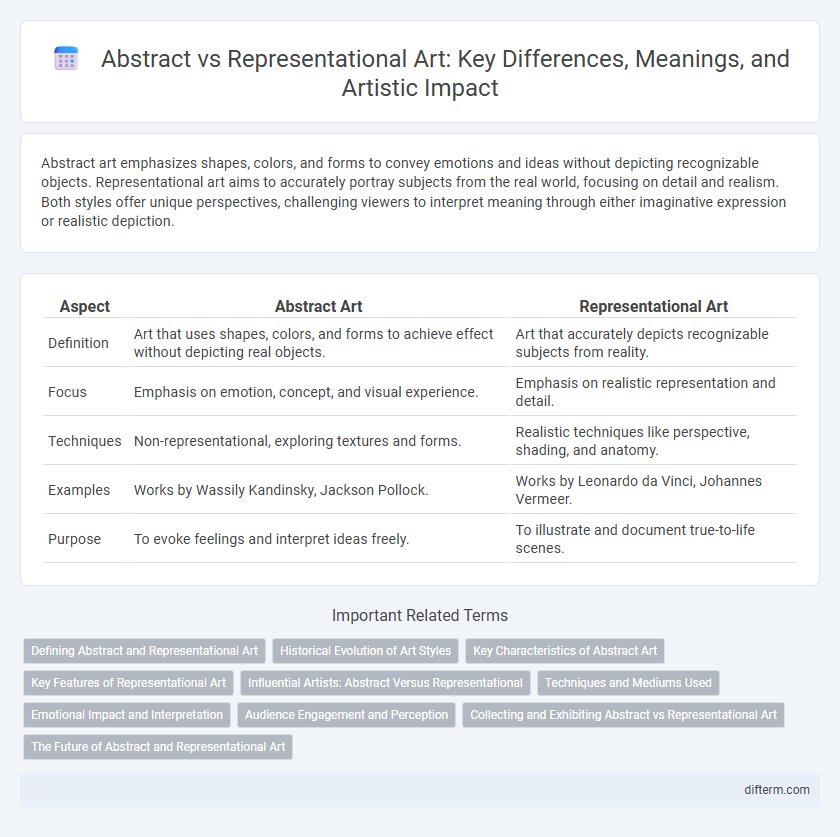Abstract art emphasizes shapes, colors, and forms to convey emotions and ideas without depicting recognizable objects. Representational art aims to accurately portray subjects from the real world, focusing on detail and realism. Both styles offer unique perspectives, challenging viewers to interpret meaning through either imaginative expression or realistic depiction.
Table of Comparison
| Aspect | Abstract Art | Representational Art |
|---|---|---|
| Definition | Art that uses shapes, colors, and forms to achieve effect without depicting real objects. | Art that accurately depicts recognizable subjects from reality. |
| Focus | Emphasis on emotion, concept, and visual experience. | Emphasis on realistic representation and detail. |
| Techniques | Non-representational, exploring textures and forms. | Realistic techniques like perspective, shading, and anatomy. |
| Examples | Works by Wassily Kandinsky, Jackson Pollock. | Works by Leonardo da Vinci, Johannes Vermeer. |
| Purpose | To evoke feelings and interpret ideas freely. | To illustrate and document true-to-life scenes. |
Defining Abstract and Representational Art
Abstract art emphasizes shapes, colors, and forms that do not directly depict real-world objects, prioritizing emotional expression and conceptual ideas. Representational art seeks to accurately portray recognizable subjects from the physical world, emphasizing realistic detail and perspective. The key distinction lies in abstraction's focus on non-literal interpretation versus representational art's commitment to visual fidelity.
Historical Evolution of Art Styles
Abstract art emerged in the early 20th century as artists like Wassily Kandinsky and Piet Mondrian broke away from representational art's focus on realistic depictions, embracing non-figurative forms that emphasized color, shape, and emotional expression. Representational art, dominant during the Renaissance and Baroque periods, aimed to depict subjects with lifelike accuracy, reflecting social, religious, and political themes of their times. The historical evolution from representational to abstract styles marks a significant shift in artistic priorities, moving from mimetic representation toward exploring inner experiences and conceptual ideas.
Key Characteristics of Abstract Art
Abstract art emphasizes color, shape, and form over realistic representation, creating a visual experience independent of recognizable subjects. It often utilizes non-representational elements, such as geometric patterns, bold brushstrokes, and dynamic compositions to evoke emotions and ideas. Key characteristics include abstraction from reality, simplification, and an emphasis on expressive use of materials and techniques.
Key Features of Representational Art
Representational art emphasizes accurate depiction of recognizable subjects, capturing realistic details such as texture, color, and proportion to create lifelike images. It often portrays people, landscapes, and objects exactly as they appear in the physical world, aiming for clarity and direct communication with viewers. This style contrasts with abstract art by prioritizing visual honesty and narrative coherence over stylistic interpretation or emotional expression.
Influential Artists: Abstract Versus Representational
Wassily Kandinsky revolutionized abstract art by emphasizing emotion through color and form, breaking from traditional representational techniques used by artists like John Singer Sargent, who focused on realistic portraiture and detailed figures. Pablo Picasso's transition between representational Cubism and abstract styles demonstrated the fluid boundaries between the two, influencing generations of artists exploring abstraction and realism. Mark Rothko's color field paintings epitomize pure abstraction, challenging viewers' perception, while Norman Rockwell's narrative realism captures everyday life with meticulous detail, showcasing the powerful impact of representational art.
Techniques and Mediums Used
Abstract art employs techniques like gestural brushstrokes, layering, and textural manipulation to evoke emotions and ideas without direct representation, often utilizing mediums such as acrylics, mixed media, and digital tools to explore form and color. Representational art relies on precise techniques including detailed shading, perspective, and proportion to depict recognizable subjects realistically, frequently using traditional mediums like oil paints, charcoal, and watercolor to capture lifelike appearances. Both styles leverage unique approaches to texture, light, and composition, with abstract art favoring experimental methods and representational art emphasizing accurate replication.
Emotional Impact and Interpretation
Abstract art evokes emotion through color, form, and texture, allowing viewers to derive personal meaning beyond literal representation. Representational art conveys familiar subjects, guiding emotional responses by depicting recognizable scenes or figures. Both styles engage the viewer's imagination differently, shaping interpretation through either ambiguity or clarity.
Audience Engagement and Perception
Abstract art challenges traditional perceptions by inviting audiences to interpret meaning through color, form, and texture, fostering personal emotional connections. Representational art offers recognizable imagery, facilitating immediate comprehension and shared cultural references that engage viewers. Audience engagement varies as abstraction provokes introspection, while representation relies on clarity and narrative to shape perception.
Collecting and Exhibiting Abstract vs Representational Art
Collecting abstract art often involves valuing emotional resonance and conceptual depth, while representational art collecting emphasizes narrative clarity and recognizable forms. Exhibiting abstract artworks requires thoughtful curation to highlight texture, color dynamics, and spatial relationships, whereas representational art exhibitions benefit from contextual information that enhances storytelling and viewer connection. Both art types demand tailored lighting and display strategies to maximize visual impact and audience engagement.
The Future of Abstract and Representational Art
Abstract art continues to evolve by embracing digital technology and immersive experiences, pushing boundaries beyond traditional paint and canvas. Representational art maintains its relevance by integrating hyperrealism and contemporary themes, appealing to modern audiences with detailed, narrative-driven works. The future of both styles lies in their hybridization, blending abstract innovation with representational clarity to create dynamic, thought-provoking visual expressions.
abstract vs representational Infographic

 difterm.com
difterm.com